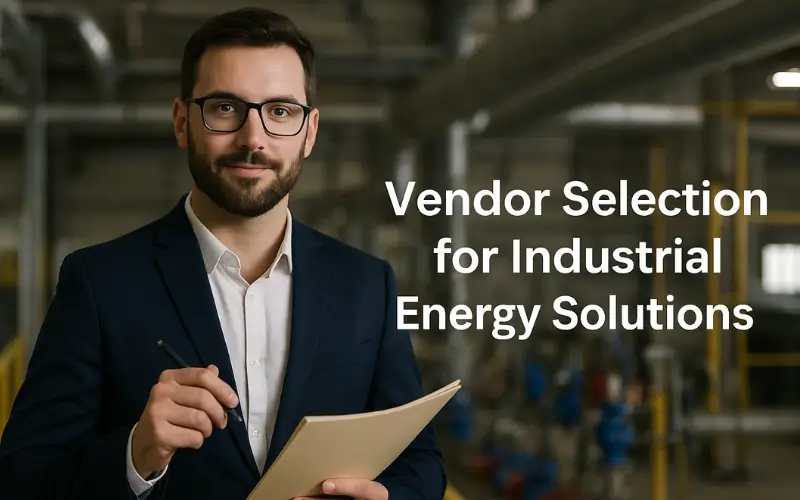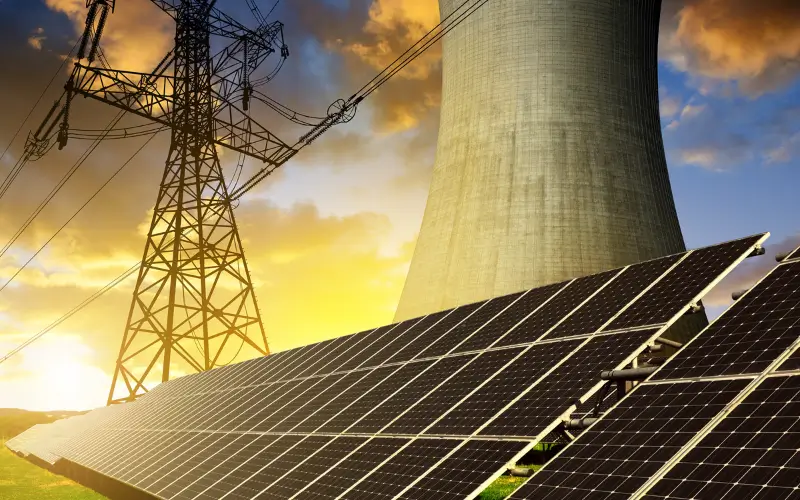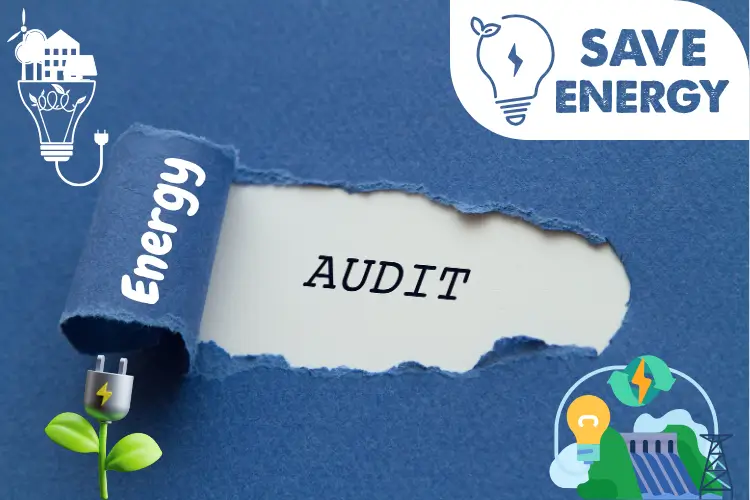In today’s competitive industrial landscape, energy efficiency isn’t just a sustainability goal—it’s a critical factor in reducing operational costs and improving productivity. Industrial energy audits provide detailed insights into how your facility consumes energy, highlighting opportunities for savings and process improvements. However, the effectiveness of an energy audit heavily depends on choosing the right vendor.
Selecting an energy audit vendor can be challenging. With numerous service providers offering different levels of expertise, methodologies, and technologies, making the wrong choice can result in inaccurate assessments, wasted resources, and missed opportunities for energy savings.
This comprehensive guide will walk you through how to select the best energy audit vendor for your industrial facility. We’ll cover everything from understanding energy audits and defining your objectives to evaluating vendor proposals, avoiding common pitfalls, and reviewing real-world case studies. By the end, you’ll have a clear, step-by-step roadmap to ensure that your energy investment yields measurable results.
Understanding Industrial Energy Audits
Before diving into vendor selection, it’s essential to understand what an industrial energy audit entails and why it matters. This knowledge will help you assess potential vendors effectively.
What Is an Industrial Energy Audit?
An industrial energy audit is a systematic evaluation of how energy is used within a manufacturing or industrial facility. The goal is to identify inefficiencies, reduce energy waste, and optimize operational performance. Key components of an energy audit typically include:
- Energy Consumption Analysis: Assessing electricity, gas, steam, and other energy sources across the facility.
- Equipment and Process Evaluation: Examining machinery, lighting, HVAC systems, and production processes for energy efficiency.
- Recommendations: Providing actionable strategies to reduce energy consumption and costs.
A well-conducted energy audit not only helps in cost savings but also supports regulatory compliance and sustainability initiatives.
Types of Energy Audits
Energy audits are generally classified into three levels, each increasing in depth and detail:
Level 1: Walkthrough Audit
- Quick assessment of overall energy use.
- Identifies obvious inefficiencies and potential savings.
- Suitable for initial evaluations or facilities with limited budgets.
Level 2: Energy Survey and Analysis
- Detailed analysis of energy consumption by system or process.
- Uses historical data, measurements, and benchmarks.
- Provides cost-effective improvement recommendations.
Level 3: Detailed Analysis (Investment-Grade Audit)
- Comprehensive audit with detailed measurements, simulations, and financial analysis.
- Recommended for large-scale energy projects or when significant capital investment is involved.
- Choosing the right audit level depends on the size of your facility, complexity of operations, and energy-saving goals.
Benefits of Conducting Energy Audits
Conducting an energy audit brings multiple benefits to industrial facilities:
- Energy Cost Savings: Identifies areas where energy consumption can be reduced, directly impacting utility bills.
- Operational Efficiency: Optimizes processes and equipment usage, improving productivity.
- Regulatory Compliance: Ensures adherence to energy efficiency standards and government regulations.
- Sustainability Goals: Supports corporate responsibility initiatives by reducing carbon footprint.
This section sets the foundation for understanding what you’re evaluating when choosing a vendor.
Criteria for Selecting an Energy Audit Vendor
Choosing the right energy audit vendor is critical to ensuring accurate assessments and meaningful energy savings. Not all vendors deliver the same level of expertise, methodology, or results. Here’s a detailed guide on the key criteria to consider.
Vendor Experience and Expertise
Industry-Specific Experience: Look for vendors who have conducted audits in facilities similar to yours. Different industries (textiles, chemicals, manufacturing) have unique energy consumption patterns.
- Certifications and Qualifications: Verify certifications such as Certified Energy Manager (CEM), ISO 50001, or other relevant professional credentials.
- Track Record: Review past projects and client testimonials to assess the vendor’s ability to deliver tangible results.
Methodology and Tools Used
- Audit Methodology: Ensure the vendor follows a structured audit process that aligns with recognized standards (e.g., ASHRAE, ISO).
- Technology and Tools: Evaluate the software, sensors, and measurement tools the vendor uses. Modern tools can improve accuracy and provide more actionable insights.
- Data Analysis Capability: Vendors should provide clear reporting and financial analysis to support decision-making.
References and Past Performance
- Case Studies: Review examples of previous audits to see measurable energy savings and improvements.
- Client References: Speak directly with past clients to understand the vendor’s communication, reliability, and support.
- Success Metrics: Assess their ability to meet timelines, cost estimates, and expected energy savings.
Cost and Value Proposition
- Pricing Structure: Understand whether the vendor charges a flat fee, per audit level, or performance-based pricing.
- ROI Assessment: Evaluate the potential return on investment from the audit recommendations versus the audit cost.
- Long-Term Value: Cheaper audits may save upfront costs but could miss key inefficiencies or lack actionable recommendations.
Compliance and Standards Adherence
- Regulatory Compliance: Ensure the vendor is familiar with local energy regulations and government reporting requirements.
- Standards Alignment: Confirm that their methodology complies with international energy efficiency standards for credibility and consistency.
This section equips you with clear benchmarks for evaluating vendors, helping you shortlist the most qualified candidates.
The Vendor Selection Process
Once you understand the criteria for evaluating vendors, the next step is to follow a structured vendor selection process. This ensures you choose a partner who can deliver accurate audits and actionable insights.
Defining Your Energy Goals
Set Clear Objectives: Identify what you want to achieve from the audit—cost savings, energy efficiency improvements, sustainability reporting, or compliance.
Align Vendor Capabilities with Goals: Ensure that the vendor’s expertise and audit methodology match your specific objectives. A mismatch can lead to irrelevant recommendations or incomplete assessments.
Request for Proposal (RFP) Best Practices
- Craft an Effective RFP: Clearly outline your facility’s energy profile, audit scope, expected deliverables, and timelines.
- Include Key Information: Provide details about energy usage patterns, facility layout, previous audits, and any specific areas of concern.
- Set Evaluation Criteria: Define how proposals will be assessed (experience, methodology, technology, cost, ROI, references).
Evaluating Proposals and Shortlisting Vendors
- Criteria for Assessment: Compare vendors based on experience, certifications, tools, methodology, references, and cost-effectiveness.
- Scoring and Ranking: Use a weighted scoring system to rank vendors objectively. Consider giving higher weight to experience and quality over cost alone.
- Shortlist Top Candidates: Narrow your options to 2–3 vendors for further engagement.
Conducting Vendor Interviews and Site Visits
- Prepare for Interviews: Develop a list of questions about audit process, tools, past experiences, and support.
- Site Visits: If possible, observe the vendor conducting a small audit or visit their client sites to assess professionalism and capability.
- Clarify Deliverables: Ensure expectations about reports, recommendations, and post-audit support are clearly defined.
Final Selection and Contract Negotiation
- Making the Final Decision: Choose the vendor who best balances expertise, methodology, technology, and cost.
- Negotiate Terms: Clearly define deliverables, timelines, pricing, and post-audit support in a formal contract.
- Set Performance Metrics: Include key performance indicators (KPIs) to measure the audit’s effectiveness and ensure accountability.
This section provides a step-by-step roadmap for selecting the most suitable energy audit vendor, minimizing risks and maximizing outcomes.
Common Pitfalls in Vendor Selection and How to Avoid Them
Even with a structured process, organizations can make mistakes when selecting an energy audit vendor. Recognizing common pitfalls helps ensure a successful partnership.
Overlooking Vendor Qualifications
- Risks of Inadequate Expertise: Choosing a vendor without proper certifications or industry experience can lead to inaccurate audits and ineffective recommendations.
- Thorough Vetting is Key: Always verify qualifications, certifications, and past project experience before shortlisting a vendor.
Focusing Solely on Cost
- Understanding the Value Proposition: Selecting the cheapest vendor may save money upfront but could compromise audit quality.
- Long-Term Benefits vs. Short-Term Savings: Evaluate potential energy savings, ROI, and the quality of recommendations. A higher initial cost often pays off with greater long-term savings.
Ignoring Post-Audit Support
- Need for Ongoing Assistance: Energy audits are not just a one-time assessment; implementation guidance and follow-up support are essential.
- Evaluate Vendor Support Services: Ensure the vendor offers support for implementing recommendations, tracking energy savings, and providing updates on new technologies or standards.
By being aware of these pitfalls, industrial facilities can make informed decisions and avoid costly mistakes during vendor selection.
Case Studies: Successful Vendor Selections
Learning from real-world examples can provide valuable insights into how effective vendor selection improves energy efficiency and operational performance.
Case Study 1: Manufacturing Facility
- Challenges Faced: High electricity bills due to inefficient machinery and outdated lighting systems.
- Vendor Selection Process: The facility issued an RFP, evaluated vendors based on experience, methodology, and ROI, and shortlisted two top candidates. Site visits and interviews were conducted before final selection.
- Outcomes Achieved: The selected vendor recommended LED retrofits, optimized machine schedules, and improved insulation. The facility saw a 15% reduction in energy costs within six months.
Case Study 2: Chemical Processing Plant
- Initial Energy Inefficiencies: Excessive steam usage, outdated HVAC systems, and poor monitoring of energy consumption.
- Audit Findings and Recommendations: The vendor conducted a Level 3 detailed audit, recommending equipment upgrades, process optimization, and real-time energy monitoring systems.
- Improvements Post-Implementation: Energy consumption dropped by 20%, with faster payback on investments and enhanced sustainability reporting for regulatory compliance.
These case studies highlight the importance of carefully selecting an experienced and capable vendor to achieve measurable energy savings and operational improvements.
Conclusion
Selecting the right energy audit vendor is a critical step for any industrial facility aiming to optimize energy consumption, reduce costs, and improve operational efficiency. A careful, methodical approach—from defining your energy goals to evaluating proposals, conducting interviews, and avoiding common pitfalls—ensures that your energy audit delivers tangible results.
By following the outlined steps, you can:
- Maximize Energy Savings: Implement actionable recommendations that reduce waste and lower utility bills.
- Ensure Quality and Reliability: Partner with a vendor who has the right expertise, methodology, and tools.
- Support Long-Term Goals: Align energy efficiency initiatives with sustainability targets and regulatory compliance.
Frequently Asked Questions (FAQs)
1. What qualifications should I look for in an energy audit vendor?
Look for vendors with industry-specific experience and certifications such as Certified Energy Manager (CEM) or ISO 50001. Verify their track record through case studies and client references.
2. How do I determine the appropriate audit level for my facility?
Audit level depends on the complexity and size of your facility. Level 1 is a basic walkthrough, Level 2 provides detailed analysis, and Level 3 is an investment-grade audit for large-scale operations.
3. What are the typical costs associated with industrial energy audits?
Costs vary based on facility size, audit level, and vendor. While Level 1 audits are more affordable, higher-level audits provide greater detail and potential ROI through actionable recommendations.
4. How can I ensure the audit recommendations are implemented effectively?
Choose a vendor who offers post-audit support, including implementation guidance, monitoring, and follow-up evaluations to ensure energy-saving measures are properly executed.
5. Are there any government incentives for conducting energy audits?
Many regions offer incentives, rebates, or tax benefits for energy efficiency projects. Check local energy agencies or government programs to see if your facility qualifies.




